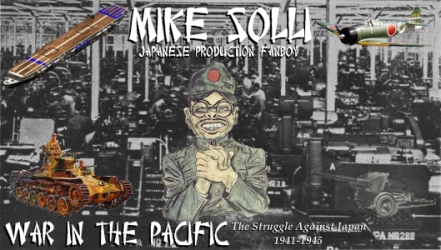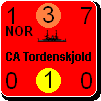Alfred
Matrix Legion of Merit

Posts: 6685
Joined: 9/28/2006
Status: offline

|
quote:
ORIGINAL: Q-Ball
ALFRED: Good thoughts from you, except invading the US West Coast? Are you mad?
Not necessarily mad To dismiss ab initio an invasion of the American continent post a successful invasion of Pearl Harbor without the benefit of some sort of staff study to assess the actual “facts on the ground”, would in my view constitute a better marker to diagnosing madness. To dismiss ab initio an invasion of the American continent post a successful invasion of Pearl Harbor without the benefit of some sort of staff study to assess the actual “facts on the ground”, would in my view constitute a better marker to diagnosing madness.
So, in order to show why my comments regarding the West Coast should not be summarily dismissed as the ramblings of a mad man, here are a few additional observations. Also bear in mind that my comments are intended to show how the momentum of a successful invasion of Pearl Harbor can be maintained. I am not arguing that invading Hawaii and thence the West Coast is superior to a full invasion of Australia, merely that your aversion to invading Hawaii is justified if you limit yourself to that limited (and expensive) operation and are not prepared to maximise your opportunities by completing the task with a move towards the West Coast. here are a few additional observations. Also bear in mind that my comments are intended to show how the momentum of a successful invasion of Pearl Harbor can be maintained. I am not arguing that invading Hawaii and thence the West Coast is superior to a full invasion of Australia, merely that your aversion to invading Hawaii is justified if you limit yourself to that limited (and expensive) operation and are not prepared to maximise your opportunities by completing the task with a move towards the West Coast.
Assumptions
(A) The sine qua non is a successful conquest of Pearl Harbor
(B) As a result of (A), Japan has command of the sea between Hawaii and the West Coast
(C) Your opponent has adopted throughout the course of 1942, the usual Allied practice of shipping from the West Coast to the Pacific islands and Australia/New Zealand, all non restricted LCUs together with all the restricted LCUs he could spend PPs to attach to unrestricted commands
(D) Just like no one expected the Spanish Inquisition in Monty Python, he will not contemplate, at least until too late, an invasion of the West Coast and therefore its defences, both in terms of units (land and air) and fortification levels will be wanting
(E) The earliest a Japanese invasion could occur is late November 1942/early December 1942
(F) There is no need to capture and maintain for long much of the West Coast, just enough to allow the by then few VPs required for a Japanese auto victory to be acquired by strategic bombing and occupation of a few bases.
Factors Assisting a Japanese Invasion of the West Coast
(1) The Allied reinforcement trigger is a Japanese invasion south of Vancouver. This means, for example, you could capture the isolated Canadian base of Coal Harbour which is only 9 hexes from Seattle. You could strategic bomb Seattle with almost no risk of facing an Allied counter invasion of Coal Harbour. Other isolated Canadian and Alaskan bases could also be captured without triggering Allied reinforcements.
(2) Allied air units in theatre will almost certainly be equipped with obsolete aircraft, probably with few airframes, and with sub 50 exp/70 air skill pilots on training.
(3) The Japanese:Allied VP ratio is favourable; the Canadian coastal bases are 10:1, the USA coastal bases which fall within the reinforcement trigger line are 20:1, with the Big 4 (Seattle, San Francisco, Los Angeles and San Diego) being 100:1. That represents a lot of VPs potentially available to Japan, even without taking into account the VPs resulting from destruction of Allied units and strategic bombing.
(4) An invasion of the West Coast represents an existential threat to the Allies. With the exception of a mirror Allied invasion of Honshu, which is totally out of the question in this timeframe, you can totally ignore any Allied offensive elsewhere. Consequently you need not fear the loss of any Japanese base in the SRA and accordingly defensive garrisons are not required. Even mandatory garrison requirements in non economic useful bases can be left unmet, thereby releasing forces for the invasion.
(5) You will be operating on shorter, interior lines than the Allies. All their 1942 forward deployment of units and logistics will be nullified. The Japanese schwerpunkt will be stronger than the deployable Allied defence (see following section “Allied West Coast Defence: Land”)
Allied West Coast Defence: Sea
A successful invasion of Pearl Harbor will maul the Allied navy. To date your opponent has relied upon an extreme Sir Robin, totally refusing any meaningful naval combat. This has allowed him to retain intact his carrier force and is probably viewed as a great achievement. I know you have lamented about the lack of opportunities to destroy the Allied fleet. What has been overlooked is that this Allied Sir Robin imposes a heavy cost to the Allied player in opportunity cost terms. Specifically, by not engaging in combat, the Allied navy has not increased its ship crew experience nor more importantly, increased the combat experience/skills of its pilots. Combined with the non attrition of the IJN (ships and pilots), this means that the non combat experienced Allied carriers (also pre Essex class and Hellcat) remain at a significant qualitative (and numerical too) disadvantage. The net result should be secure Japanese SLOC from Hawaii to West Coast.
Allied West Coast Defence: Land
I fully expect the West Coast to be seriously under prepared for a Japanese invasion. To give an indication of what you might encounter (refer back to my assumption (C) above) consider the following tables. For the purposes of this preliminary discussion I have limited myself to only infantry and armour units.
Table 1. 7 December 1941 Infantry + Armour OOB on the West Coast
Command Unit Name Assault Value PP Cost Withdrawal Date
West Coast 3 Inf Div, 287 AV, N/A, 1 Sept 1942
West Coast 7 Mot Inf Div, 399 AV, N/A, 1 Feb 1943
West Coast 41 Inf Div, 230 AV, 1198 PP, N/A
West Coast 11 Cav (Hrse) Rgt, 52 AV, N/A, 786 days
Pacific Fleet 34 Inf Rgt, 115 AV, N/A, N/A
West Coast 53 (Sep) Inf Rgt, 79 AV, 305 PP, 1029 days
West Coast 87 Mtn Rgt, 29 AV, 113 PP, 724 days
West Coast 115 Cav (H&M) Rgt, 69 AV, N/A, 907 days
West Coast 159 Mot Inf Rgt, 79 AV, 305 PP, 968 days
West Coast 160 Inf Rgt , 91 AV, 472 PP, N/A
West Coast 185 Inf Rgt, 88 AV, 467 PP, N/A
West Coast 2 Mar Rgt, 38 AV, 231 PP, N/A
Pacific Fleet 8 Mar Rgt, 116 AV, N/A, N/A
West Coast 1/153 Inf Bn, 33 AV, 122 PP, 815 days
West Coast 2 USMC Para Bn, 19 AV, 35 PP, 815 days
West Coast 752 Tank Bn, 38 AV, N/A, 1 Aug 1942
West Coast 756 Tank Bn, 34 AV, N/A, 1 Jan 1943
West Coast 757 Tank Bn, 34 AV, N/A, 1 Mar 1943
By 1 December 1942, the two units attached to Pacific Fleet HQ will have been redeployed, probably to Pearl Harbor initially. Also expected to have been redeployed overseas by this date are:
41 Inf Div
53 (Sep) Inf Rgt
87 Mtn Rgt
159 Mot Inf Rgt
160 Inf Rgt
185 Inf Rgt
2 Mar Rgt
1/153 Inf Bn
2 USMC Para Bn
The total full PP cost to reattach these units (i.e. not using the 75% discount method) is 3248. At a daily accumulation rate of 50 PPs, approximately 2 months of PPs would be expended. Clearly this is very achievable even at the full retail cost.
That leaves us with only 6 units totalling about 590 AV still attached permanently to West Coast HQ by 1 December 1942. Note the scheduled departure from the OOB of 7 Mot Inf Div and 756 Tank Bn by 1 Feb 1943. This represents a substantial weakening of the Allied capacity to stave off an auto VP loss in early 1943.
The next table lists the scheduled West Coast Command infantry and armour units which arrive by 1 December 1942. Some of these units will probably be transferred to unrestricted commands and have been shipped overseas by the time of the Japanese invasion. To err on the conservative side however, I will treat them all as still stationed on the West Coast and factor in only those newly arriving units already attached to unrestricted HQs as having been shipped overseas by 1 December 1942.
Table 2. West Coast HQ Infantry + Armour arriving by 1 December 1942
Unit Name, Assault Value, Withdrawal Date
5 Arm Div, 99 AV, 24 Mar 1943
6 Arm Div, 99 AV, N/A
13 Arm Div, 99 AV, N/A
27 Inf Div, 204 AV, N/A
35 Inf Div, 390 AV, 1 Jan 1943
43 Inf Div, 390 AV, N/A
44 Inf Div, 390 AV, N/A
91 Inf Div, 81 AV, N/A
104 Inf Div, 81 AV, N/A
107 Cav (H&M) Rgt, 91 AV, N/A
108 Inf Rgt , 88 AV, N/A
125 Inf Rgt, 115 AV, N/A
138 (Sep) Inf Rgt, 78 AV, N/A
140 Inf Rgt , 115 AV, N/A
144 Inf Rgt, 115 AV, 1 Jan 1943
164 Inf Rgt, 112 AV, N/A
3 Mar Raider Bn, 40 AV, N/A
2 USMC Tank Bn, 86 AV, N/A
The total Assault Value of these units is: 2673. Many of these units arrive significantly under strength but it is likely that priority to filling out the TOE will be given to units overseas. Again note the units scheduled to be withdrawn by 1 January 1943. Also, even if all these units remain stationed on the West Coast, they have to be spread out amongst many coastal bases which almost certainly have neglected the construction of fortification levels. Nor will they be stationed on the Channel Islands or on the remote Canadian/Alaskan bases which lie outside the reinforcement trigger zone.
I would totally concur with the view that Japan lacks the assets to remain in both India and the American continent for long in 1943 if Allied reinforcements are triggered in either hemisphere. The length of stay would be slightly extended if no Allied reinforcements are triggered. But that is not the objective. The objective from day 1 of this war has been to secure a Japanese auto victory in the short term. My comments should be seen in the light of that short term objective. If you were aiming for the long term, then other considerations, such as security of raw materials, would come to the fore.
Alfred
|
 Printable Version
Printable Version















 To dismiss ab initio an invasion of the American continent post a successful invasion of Pearl Harbor without the benefit of some sort of staff study to assess the actual “facts on the ground”, would in my view constitute a better marker to diagnosing madness.
To dismiss ab initio an invasion of the American continent post a successful invasion of Pearl Harbor without the benefit of some sort of staff study to assess the actual “facts on the ground”, would in my view constitute a better marker to diagnosing madness.  here are a few additional observations. Also bear in mind that my comments are intended to show how the momentum of a successful invasion of Pearl Harbor can be maintained. I am not arguing that invading Hawaii and thence the West Coast is superior to a full invasion of Australia, merely that your aversion to invading Hawaii is justified if you limit yourself to that limited (and expensive) operation and are not prepared to maximise your opportunities by completing the task with a move towards the West Coast.
here are a few additional observations. Also bear in mind that my comments are intended to show how the momentum of a successful invasion of Pearl Harbor can be maintained. I am not arguing that invading Hawaii and thence the West Coast is superior to a full invasion of Australia, merely that your aversion to invading Hawaii is justified if you limit yourself to that limited (and expensive) operation and are not prepared to maximise your opportunities by completing the task with a move towards the West Coast. 










 New Messages
New Messages No New Messages
No New Messages Hot Topic w/ New Messages
Hot Topic w/ New Messages Hot Topic w/o New Messages
Hot Topic w/o New Messages Locked w/ New Messages
Locked w/ New Messages Locked w/o New Messages
Locked w/o New Messages Post New Thread
Post New Thread